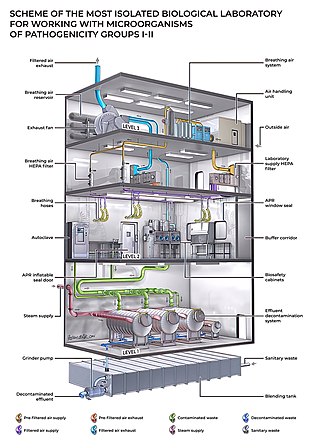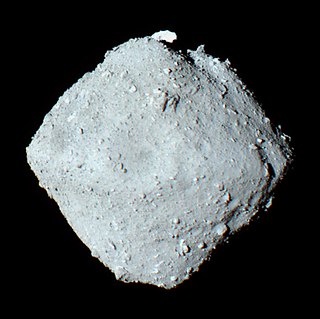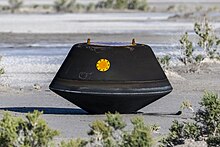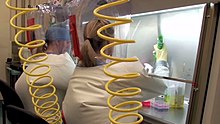
A biosafety level (BSL), or pathogen/protection level, is a set of biocontainment precautions required to isolate dangerous biological agents in an enclosed laboratory facility. The levels of containment range from the lowest biosafety level 1 (BSL-1) to the highest at level 4 (BSL-4). In the United States, the Centers for Disease Control and Prevention (CDC) have specified these levels in a publication referred to as BMBL. In the European Union, the same biosafety levels are defined in a directive. In Canada the four levels are known as Containment Levels. Facilities with these designations are also sometimes given as P1 through P4, as in the term P3 laboratory.

A biological hazard, or biohazard, is a biological substance that poses a threat to the health of living organisms, primarily humans. This could include a sample of a microorganism, virus or toxin that can adversely affect human health. A biohazard could also be a substance harmful to other living beings.

Planetary protection is a guiding principle in the design of an interplanetary mission, aiming to prevent biological contamination of both the target celestial body and the Earth in the case of sample-return missions. Planetary protection reflects both the unknown nature of the space environment and the desire of the scientific community to preserve the pristine nature of celestial bodies until they can be studied in detail.
The Lunar and Planetary Institute (LPI) is a scientific research institute dedicated to study of the solar system, its formation, evolution, and current state. The Institute is part of the Universities Space Research Association (USRA) and is supported by the Science Mission Directorate of the National Aeronautics and Space Administration (NASA). Located at 3600 Bay Area Boulevard in Houston, Texas, the LPI is an intellectual leader in lunar and planetary science. The Institute serves as a scientific forum attracting world-class visiting scientists, postdoctoral fellows, students, and resident experts; supports and serves the research community through newsletters, meetings, and other activities; collects and disseminates planetary data while facilitating the community's access to NASA astromaterials samples and facilities; engages and excites the public about space science; and invests in the development of future generations of scientists. The LPI sponsors and organizes several workshops and conferences throughout the year, including the Lunar and Planetary Science Conference (LPSC) held in March in the Houston area.
The interplanetary dust cloud, or zodiacal cloud, consists of cosmic dust that pervades the space between planets within planetary systems, such as the Solar System. This system of particles has been studied for many years in order to understand its nature, origin, and relationship to larger bodies. There are several methods to obtain space dust measurement.

A sample-return mission is a spacecraft mission to collect and return samples from an extraterrestrial location to Earth for analysis. Sample-return missions may bring back merely atoms and molecules or a deposit of complex compounds such as loose material and rocks. These samples may be obtained in a number of ways, such as soil and rock excavation or a collector array used for capturing particles of solar wind or cometary debris. Nonetheless, concerns have been raised that the return of such samples to planet Earth may endanger Earth itself.

A Mars sample-return (MSR) mission is a proposed mission to collect rock and dust samples on Mars and return them to Earth. Such a mission would allow more extensive analysis than that allowed by onboard sensors.

Hayabusa2 is an asteroid sample-return mission operated by the Japanese state space agency JAXA. It is a successor to the Hayabusa mission, which returned asteroid samples for the first time in June 2010. Hayabusa2 was launched on 3 December 2014 and rendezvoused in space with near-Earth asteroid 162173 Ryugu on 27 June 2018. It surveyed the asteroid for a year and a half and took samples. It left the asteroid in November 2019 and returned the samples to Earth on 5 December 2020 UTC. Its mission has now been extended through at least 2031, when it will rendezvous with the small, rapidly-rotating asteroid 1998 KY26.

Extraterrestrial material refers to natural objects now on Earth that originated in outer space. Such materials include cosmic dust and meteorites, as well as samples brought to Earth by sample return missions from the Moon, asteroids and comets, as well as solar wind particles.

101955 Bennu (provisional designation 1999 RQ36) is a carbonaceous asteroid in the Apollo group discovered by the LINEAR Project on 11 September 1999. It is a potentially hazardous object that is listed on the Sentry Risk Table and has the highest cumulative rating on the Palermo Technical Impact Hazard Scale. It has a cumulative 1-in-1,750 chance of impacting Earth between 2178 and 2290 with the greatest risk being on 24 September 2182. It is named after Bennu, the ancient Egyptian mythological bird associated with the Sun, creation, and rebirth.

162173 Ryugu, provisional designation 1999 JU3, is a near-Earth object and a potentially hazardous asteroid of the Apollo group. It measures approximately 900 metres (3,000 ft) in diameter and is a dark object of the rare spectral type Cb, with qualities of both a C-type asteroid and a B-type asteroid. In June 2018, the Japanese spacecraft Hayabusa2 arrived at the asteroid. After making measurements and taking samples, Hayabusa2 left Ryugu for Earth in November 2019 and returned the sample capsule to Earth on 5 December 2020. The samples showed the presence of organic compounds, such as uracil (one of the four components in RNA) and vitamin B3.
Interplanetary contamination refers to biological contamination of a planetary body by a space probe or spacecraft, either deliberate or unintentional.

OSIRIS-REx was a NASA asteroid-study and sample-return mission that visited and collected samples from 101955 Bennu, a carbonaceous near-Earth asteroid. The material, returned in September 2023, is expected to enable scientists to learn more about the formation and evolution of the Solar System, its initial stages of planet formation, and the source of organic compounds that led to the formation of life on Earth. Following the completion of the primary mission, the spacecraft is planned to conduct a flyby of asteroid 99942 Apophis as OSIRIS-APEX.

A planetary surface is where the solid or liquid material of certain types of astronomical objects contacts the atmosphere or outer space. Planetary surfaces are found on solid objects of planetary mass, including terrestrial planets, dwarf planets, natural satellites, planetesimals and many other small Solar System bodies (SSSBs). The study of planetary surfaces is a field of planetary geology known as surface geology, but also a focus on a number of fields including planetary cartography, topography, geomorphology, atmospheric sciences, and astronomy. Land is the term given to non-liquid planetary surfaces. The term landing is used to describe the collision of an object with a planetary surface and is usually at a velocity in which the object can remain intact and remain attached.

The Lunar Sample Laboratory Facility (LSLF) is a repository and laboratory facility at NASA's Lyndon B. Johnson Space Center in Houston, Texas, opened in 1979 to house geologic samples returned from the Moon by the Apollo program missions to the lunar surface between 1969 and 1972. The facility preserves most of the 382 kilograms (842 lb) of lunar material returned over the course of Apollo program and other extraterrestrial samples, along with associated data records. It also contains laboratories for processing and studying the samples without contamination.

CAESAR is a sample-return mission concept to comet 67P/Churyumov–Gerasimenko. The mission was proposed in 2017 to NASA's New Frontiers program mission 4, and on 20 December 2017 it was one of two finalists selected for further concept development. On 27 June 2019, the other finalist, the Dragonfly mission, was chosen instead.

The Planetary Material Sample Curation Facility (PMSCF), commonly known as the Extraterrestrial Sample Curation Center is the facility where Japan Aerospace Exploration Agency (JAXA) conducts the curation works of extraterrestrial materials retrieved by some sample-return missions. They work closely with Japan's Astromaterials Science Research Group. Its objectives include documentation, preservation, preparation, and distribution of samples. All samples collected are made available for international distribution upon request.

















